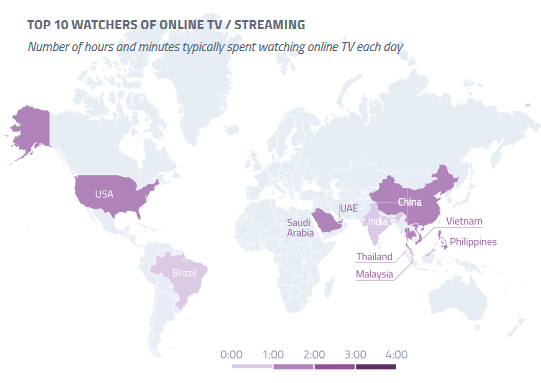Home > Media News >

Source: http://arabianmarketer.ae
The shift from traditional to digital media is much discussed but rarely quantified. From a Middle East & Africa perspective, especially to better understand markets such as the UAE and Saudi Arabia where digital is already a lead medium, it is imperative to know the change in numbers.
In a recent report, Global Web Index aims to offer a perspective on day-to-day media consumption behaviors by age and across 34 markets – analyzing how much time people are spending online, tracking the types of media they are consuming and assessing the share of time spent on digital and on traditional forms of television, radio and print press.
Needless to say, both UAE and Saudi Arabia feature prominently on any metric that is in context to mobile penetration or changing consumer behavior on the back of this.

National Differences in Media Consumption
• There are now seven markets where people are watching online TV for an average of more than one hour per day. Fast-growth nations in the Middle East are at the forefront here.
• There are just five of the 34 markets tracked by GWI where consumers are spending longer each day on traditional rather than digital forms of media.
• Daily time spent online on mobiles is much higher in fast-growth markets (where online populations tend to have younger age profiles). Mobiles are now capturing 40-50 percent of online time in most fast-grown markets, while the equivalent figure dips down to 25 percent or below in places like France and Belgium.
Traditional vs Digital: TV, Radio and Press
• Across 31 markets where trended data from 2012 onwards is available, daily time spent on linear TV has declined in 29 of them, broadcast radio is down in 24 countries and physical print press has dipped in 15 of them.
Meanwhile, online TV has recorded increases in 28 of 31 countries and online press has risen in 26 places.

• Traditional forms of media are not being abandoned, though. Despite constant claims that the internet is taking people away from other formats, most of them are holding their own. Linear TV remains ahead of online TV in all 34 markets and represents the single biggest daily media activities. It’s for press that we see a different picture: here, online is ahead of print editions in all but two markets.
Global Trends in Media Consumption
• On a typical day, internet users now estimate that they spend more than six hours online. Smartphones are becoming ever more prominent within this. Since 2012, daily time spent online on mobiles has jumped from 1 hour 17 minutes to 2 hours 30 minutes. Significantly, the share of internet time captured by smartphones has risen from 23 percent to 39 percent.
• Over the same period, PCs/laptops have seen small declines but they continue to retain an important role even as mobiles continue to climb. It’s clear that smartphones are simply encouraging us to spend longer periods of time online each day, rather than do so at the direct expense of traditional devices.
• Online TV has seen small and consistent increases and is now capturing almost an hour of time each day. Consumers are still spending over twice as long watching broadcast TV (2 hours 5 minutes) though, highlighting that traditional formats are still holding their own.
• Social networks/services capture the largest share of online media time (32 percent). Over two hours per day is being spent on social networks/services – 34 minutes more than was being spent back in 2012.
• Simultaneous multi-media consumption is now the norm: over 85% are using another device as they watch television. Mobiles are the chosen device for this, with social networking and chatting to friends the top activities.
Right Now

16 Jul, 2025 / 09:31 AM
Google inks $3 billion US hydropower deal in largest clean energy agreement of its kind
Top Stories









